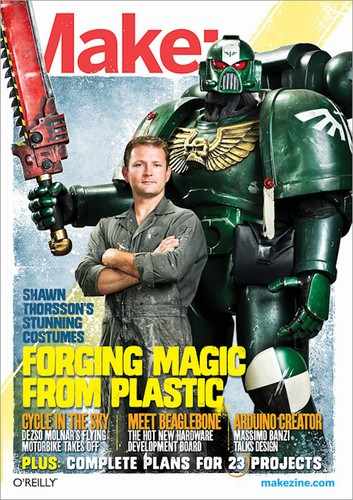FEATURES DEZSO MOLNAR
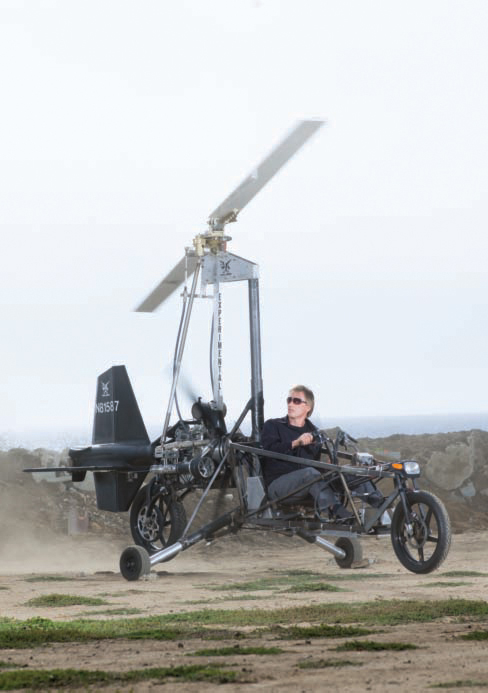
Dezso Molnar fires up the original Molnari GT gyrocycle.
The Buckaroo BANZAI of Flight
DEZSO MOLNAR ELEVATES FLYING MOTORCYCLES FROM FICTION TO FACT
Photographed by Cody Pickens
The 14,000-square-foot Calfee Design factory is perched on the edge of a bluff in La Selva Beach, Calif. Below the bluff, the Pacific rumbles and moans. Above it, in the shop, on most days they build bicycles. Some of the best in the world, in fact. But today is not most days.
Today is October 20, 2005. A man named Dezso (pronounced DEZH-ur) Molnar is pushing a strange, four-wheeled contraption out of the warehouse and onto a 2,000-foot runway. A few years back, when Molnar was hunting for a place to build this machine, he had three key needs. The first was isolation. His skunkworks project was the kind of build that attracted all sorts of unwanted attention. Calfee’s warehouse fit the bill. It sits on 379 acres of private land and sees few visitors. His second need was expertise. Molnar’s contraption had to be light — very light. Calfee’s bicycles are made from carbon fiber. They weigh about 14 pounds. Calfee understood light. Molnar’s last requirement was a straight stretch of pavement. It didn’t have to be a runway, but considering the nature of Molnar’s invention, it was a fitting touch.
The true nature of Molnar’s invention is hard to discern at a glance. It looks like some Mad Max version of a recumbent bicycle, only with training wheels, a chromoly steel roll cage, and a 68-inch, 3-blade propeller cutting through the middle. Today is the very first day Molnar is going to fire up that propeller and see if it can push his machine down the road. He’s hoping for speeds about 50mph because, at least according to Molnar’s calculations, that’s about what it should take to get his flying motorcycle off the ground.
THE DREAM OF FLIGHT
The flying car and the flying motorcycle are the stuff of dreams — very old dreams. Aviation pioneer Glenn Curtiss invented the first flying car back in 1917: a 40-foot-long tri-winged beast made from aluminum. The beast never did fly, but it managed to hop. That hop was enough, inspiring almost a century of innovation. Next came Waldo Waterman’s 1937 winged Studebaker — dead for lack of funding. A bad crash destroyed the 1947 ConvAirCar. The Aerocar went through six iterations before the oil crisis of the 1970s killed off production plans. Since then, there have been dozens of other attempts; a few have flown, most have not.
Flights of Fancy
The dream of flying cars has been around for at least as long as the first airplanes.
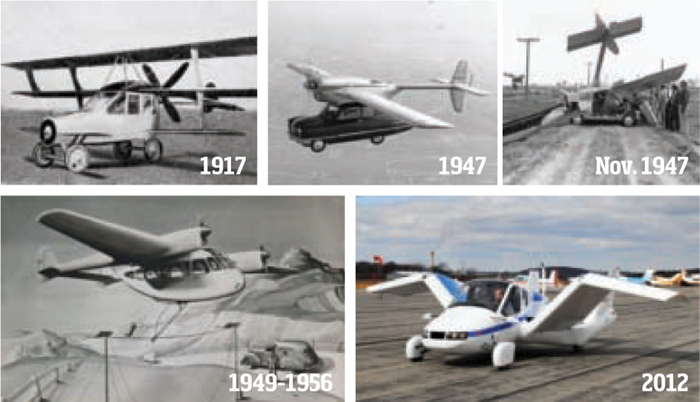
(Clockwise from top left) The first flying car, Glenn Curtiss’ 40-foot-long tri-winged beast made from aluminum (1917); the ConvAirCar, before and after an unscheduled landing (1947); the Aerocar, perhaps the most famous of roadworthy aircraft (1949–1956); and the folding-wing Terrafugia Transition (2012).
Historic photos courtesy of the San Diego Air & Space Museum; Terrafugia
Today, the two most widely known versions are Paul Moller’s M400 Skycar and the Terrafugia Transition. Both of these vehicles are currently for sale; neither of them have actually been delivered to a customer. And that’s really the issue. Out of 104 roadworthy aircraft (80 of which have patents on file), none have seen mass production.
There are, of course, good reasons for this. While the upside of a flying car is easy to imagine — no traffic jams, shorter commutes, another excuse to quote Blade Runner — the downsides are considerable. Cost and noise, for starters (at $279,000, the Transition has been branded a rich man’s toy, to say nothing of Skycar’s initial $3.5 million price). But safety and ease-of-use are the bigger stumbling blocks. As with anything that flies, the consequences of pilot error can be severe, especially in bad weather. The safest pilots are the ones with the most practice and the best knowledge of their airplane, twin requirements that further put the flying car out of reach of the average citizen. Moreover, right now, most small planes are high-maintenance, requiring constant (and expensive) upkeep. They also tend to be gas guzzlers. Flying cars, if they’re to become become everyman tools, can be neither. And this list doesn’t include the bevy of concerns that arrive when one wants to create a street-legal aircraft.
THE PRACTICAL DREAMER
Until about eight years ago, Molnar had never intended to get into the street-legal aircraft business, but considering the nature of his pedigree, perhaps it was inevitable. Molnar flew hot air balloons as a teenager, then paid his way through college by flying planes in the Air Force and moonlighting at Truax Engineering, where Robert Truax had a Navy contract for building a replacement vehicle for the space shuttle (this was right after the Challenger crash). They built a workable rocket (they were awarded the contract), but funding issues shut down the effort. Afterward, Molnar spent a few years playing music in bands, building robots with the machine performance art outfit Survival Research Labs, and designing DIY vehicles like his buzz-bomb jet-powered go-kart. He next signed on as a crew chief for Craig Breedlove’s attempt to drive a jet car through the sound barrier. When that project ran its course, Molnar jumped back into music, and that’s where he might have stayed had it not been for London’s 2003 heat wave.
“In 2003, I was in the U.K. shooting a music video. It was hot and fun until I got back to Los Angeles, where it was foggy and dew was dripping from the walls in my house. I called a friend and suggested we drive out to Palm Springs, just to warm up. But it was the middle of the day and my friend worked downtown, and the traffic there was bumper-to-bumper. We were trapped. We couldn’t leave.”
And that’s when Molnar got curious about the kind of vehicle that could beat this traffic. He wasn’t interested in fairy tales, he was interested in practicality. A flying car capable of vertical takeoff was the most common response, but the only thing that could take off vertically was a helicopter, and those were both expensive and difficult to pilot. But what if he threw that requirement out the window? There are 14,000 airports in America, 30 in the L.A. area alone. What if you could depart from those airports (which typically sit in less congested areas, so getting there isn’t as much of an issue) and land in a congested area? There are dozens of parking garages in downtown L.A. — what if you could land atop one of those?
Then Molnar remembered an advertisement from his childhood for a gyrocopter, a type of “rotorcraft” invented in the 1920s by Spanish engineer Juan de la Cierva. Gyrocopters use an unpowered rotor for lift (like a helicopter in autorotation), an engine-powered propeller for thrust (like a plane), and have the advantage of being able to land at very slow speeds (to maximize pilot safety) in extremely small spaces (like the roof of a parking garage). Even better, gyroplanes are cheap — kits start at 10,000 bucks — and easy to fly: a sport pilot’s license is required, with just 20 hours of flight time. There was one small issue, however: gyroplanes had a bad habit of crashing.
“The problem,” says Molnar, “is that the most popular gyroplane on the market was designed without a horizontal stabilizer — which is what keeps a plane’s nose from pitching up or down. People kept getting killed because of it, and too often it was considered pilot error. The gyroplane was originally designed to create a safe wing that would not stall, but the perceived option of removing the horizontal stabilizer was a design error. If you put the stabilizer back on, the result is potentially one of the world’s safest aircraft — and one that can land in less than 20 feet.”
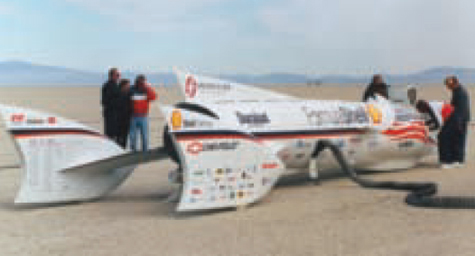
(Top) Molnar was crew chief for Craig Breedlove during his attempt to break the sound barrier in a car in 1992.

(Bottom) Molnar takes his buzz-bomb jet-powered go-kart for a spin.
Greg Hain (go-kart)
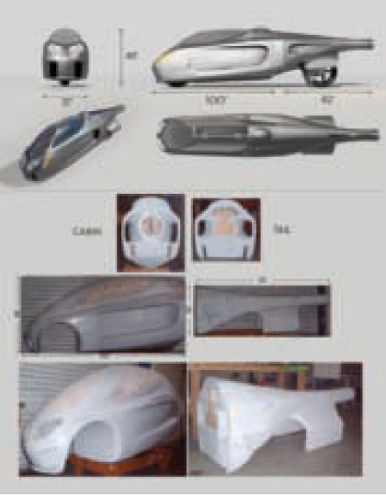
(Right) Plugs for casting composite body panels for the GT.

(Below) The geometry of a street-legal gyrocycle guides the progression of the GT’s fairing design.
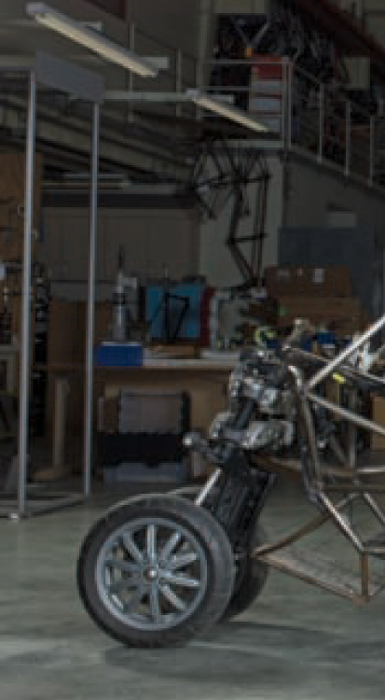
Molnar had solved only part of the problem. He could land in a congested area, but he still had to evade traffic on his way out. “I took a very realistic approach to this question. Since vertical takeoff is too limiting, and no one’s going to build a long runway in places like downtown Los Angeles, then flying away isn’t the solution. You need to be able to drive. This is where the motorcycle comes in. If you drive away on a motorcycle you can split lanes. It’s the fastest way to get away from traffic, and it’s legal in 25 countries.”
What made the motorcycle even more interesting was the engine. Motorcycle engines are cheap (a new one costs around $2,000 versus $36,000 for most aircraft engines), powerful, durable, quiet, get great gas mileage, and — their best feature — standardized. “Because these engines always have to fit between the driver’s legs,” says Molnar, “manufacturers devote tremendous time and energy to keep them within racing-restricted displacements (up to 999ccm), yet make them increasingly more powerful. Motorcycle engines are constantly getting better, and you can get them repaired at any roadside shop. It’s a perfect solution.”
All of these ideas came together in the vehicle Molnar wheeled onto the tarmac that October 2005 afternoon, the Molnari GT gyro-cycle. The test drive went exactly according to plan. The one-cylinder engine and propeller generated more than enough wind to push the vehicle past the 50mph mark. Road tests confirmed it could master the freeways: the two-wheeled bike did 90mph no problem. (The newer, tri-wheeled G2 does 160mph and handles like a sports car.) Because of his engine choice, Molnar also evaded a problem that plagued Moller and Terrafugia: his vehicle passed a smog test. The bike was street legal. Now it was time to see if it could fly.
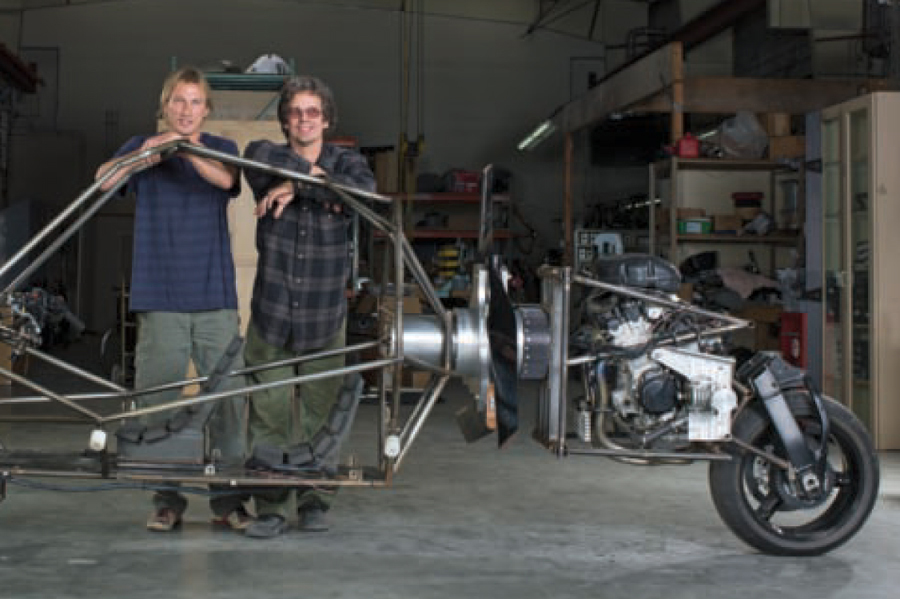
Dezso Molnar and Craig Calfee prepare the latest version of the gyrocycle, the Molnari G2, for upcoming road testing at Bonneville Salt Flats, Utah.
DREAMS REALIZED
The first flight took place in 2006, and everything went perfectly. The crew logged four hours of flight time without a mishap, so Molnar started thinking about production. Originally, his plan was to sell single-seaters, constructed from kits. But his backers wanted to explore upscale markets — which meant two seats, room for cargo, and all kinds of doodads. So Molnar and his partners spent years working on the new G2 while trying to convince the FAA that gyroplanes could be engineered safe enough to be sold as turn-key light sport aircraft. The FAA wouldn’t budge, so Molnar went back to his roots.
“I decided,” he says, “that this had to be a DIY project. The FAA won’t allow a ready-made gyroplane, but tens of thousands of aircraft flying are homebuilt, and the FAA regulations allow gyroplanes that are built from kits. I had a machine that could fly and drive, but if it was going to help launch the flying car revolution, then DIYers would need to assemble their own to push it forward.”
Unlike kit airplanes, which can take years to build in a hangar, Molnar thinks the G2 could be snapped together in a garage in four weeks. But it hasn’t been engineered for production, or optimized. Engineering, he feels, is easy; it could even be crowdsourced. But optimization requires testing — and this is where Molnar’s business plan deviates further from his peers. Rather than drum up financing for mass production, Molnar wants to establish a gyrocycle racing league populated entirely by kit builders.
“Sure, it’s not a huge market, but this is not a machine for couch potatoes,” Molnar says. “It’s for skydivers and guys who ride Ninjas. These people live for adventure, they know they’re on the cutting edge, and consider what happens if we’re successful: suddenly the chuckle factor is gone from the flying car discussion. In its place, you get all the optimization and engineering that results from any race program, and nobody streamlines better than a racing pit crew.” ![]()
Steven Kotler’s (stevenkotler.com) books include Abundance, A Small Furry Prayer, and the novel The Angle Quickest for Flight.
